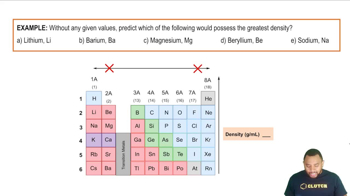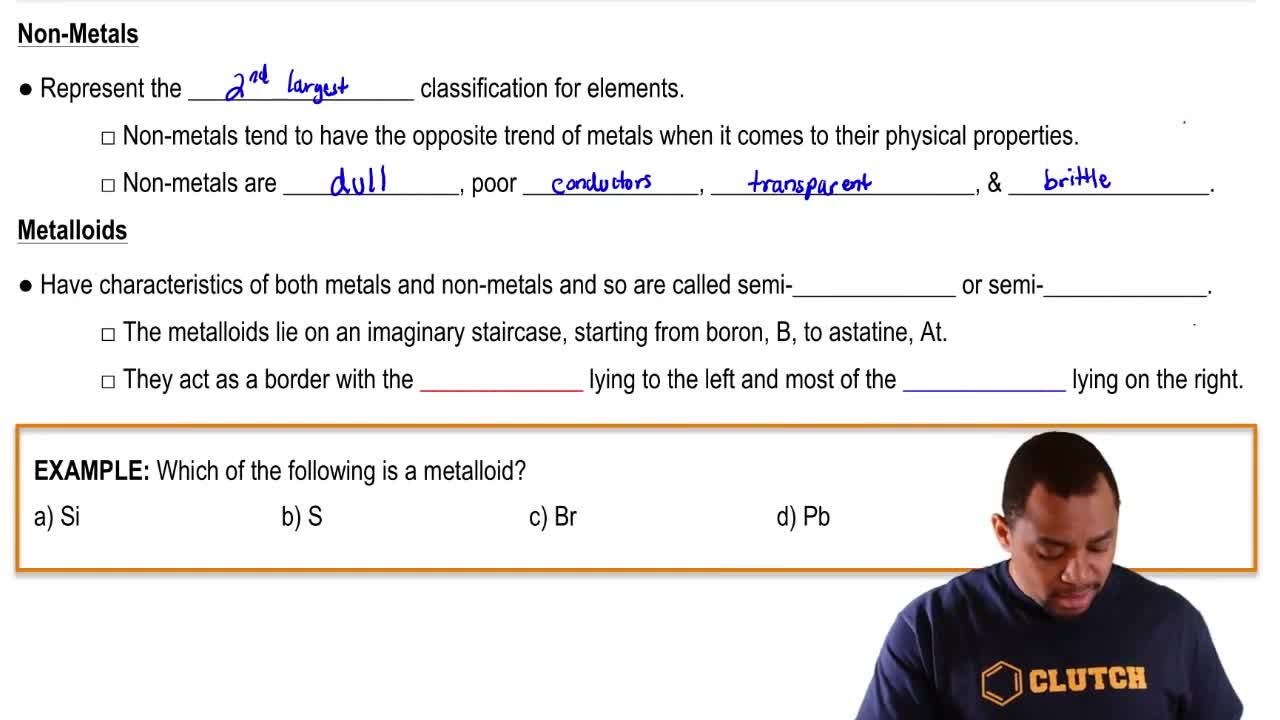Ch.22 - Chemistry of the Nonmetals
Chapter 22, Problem 72
Complete the exercises below. Select the member of group 4A that best fits each description: a. forms chains to the greatest extent, b. forms the most basic oxide, c. is a metalloid that can form an oxide.
 Verified step by step guidance
Verified step by step guidance1
Step 1: Identify the elements in group 4A of the periodic table. These elements are carbon (C), silicon (Si), germanium (Ge), tin (Sn), and lead (Pb).
Step 2: For part (a), consider which element forms chains to the greatest extent. Carbon is known for its ability to form long chains and complex structures due to its tetravalency and ability to form stable covalent bonds with itself.
Step 3: For part (b), determine which element forms the most basic oxide. Basic oxides are typically formed by metals. In group 4A, tin (Sn) and lead (Pb) are metals, and their oxides tend to be more basic compared to the oxides of nonmetals or metalloids.
Step 4: For part (c), identify the metalloid in group 4A that can form an oxide. Silicon (Si) and germanium (Ge) are metalloids in this group. Both can form oxides, but silicon is more commonly known for forming silicon dioxide (SiO₂).
Step 5: Review the properties of each element in group 4A to ensure the correct selection for each description, considering their chemical behavior and common compounds they form.
Key Concepts
Here are the essential concepts you must grasp in order to answer the question correctly.
Group 4A Elements
Group 4A of the periodic table includes carbon (C), silicon (Si), germanium (Ge), tin (Sn), and lead (Pb). These elements exhibit a range of properties, from nonmetals to metals, and are known for their ability to form covalent bonds. Understanding their bonding characteristics is essential for predicting their behavior in various chemical reactions.
Recommended video:
Guided course

Main Group Elements: Density Example
Oxide Formation
Oxides are compounds formed when elements react with oxygen. The nature of the oxide (acidic, basic, or amphoteric) depends on the element's position in the periodic table. For example, nonmetals typically form acidic oxides, while metals form basic oxides. Recognizing the type of oxide formed by each Group 4A element is crucial for answering the question.
Recommended video:
Guided course

Enthalpy of Formation
Metalloids
Metalloids are elements that exhibit properties of both metals and nonmetals. In Group 4A, silicon and germanium are classified as metalloids. They can form covalent bonds and oxides, which can display amphoteric behavior, meaning they can react with both acids and bases. Identifying metalloids is important for understanding their unique chemical properties.
Recommended video:
Guided course

Metalloid Properties
Related Practice
